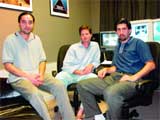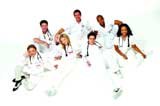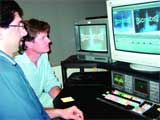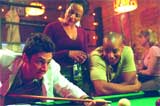
Scrubs is shot on 16mm. Pictured are (L-R) DigitalFilm Tree CEO Ramy Katrib, assistant editor Scott Burnette and DFT editor Edvin Mehrabyan.
|
BURBANK - Scott Burnette, an assistant editor on the NBC sitcom Scrubs, has been on a mission to find the perfect streamlined, cost-effective editing system. About two years ago while at NAB he saw Apple Final Cut Pro and an assortment of uncompressed video cards - Aurora Video Systems' IgniterRT, Digital Voodoo's D1 and Pinnacle Systems' CineWave - so he knew that broadcast quality was possible on a desktop system.
Today Scrubs - a program he online edited through its first season in an Avid Symphony room at Level 3 Post - is being cut at DigitalFilm Tree in Burbank on an AJA Kona SD-enhanced Final Cut Pro system. By next season, budget willing, the producers plan to bring that online system on site and perhaps, according to post production supervisor Nicholas Scaramuzzo, even switch to HD. That would give Scrubs the ability to go from first shot to final cut (no pun intended) right on location.

Scrubs is shot over five days in an abandoned hospital. The show may be finished there next season as well.
|
Scrubs, almost entirely produced in an abandoned hospital, shoots single-camera Super 16mm on an Aaton XTR Prod PL in 4:3 and is protected for 16:9. Cinematographer John Inwood shoots all the shows. "We have a five-day-per-episode shoot schedule. We do a lot of Steadicam work and get one day a week for two-camera shoots." Inwood lenses about 18,000 feet of film per episode.
Dailies are transferred to Digi Beta at Level 3 Post (www.level3post.com) on a Cintel C-Reality. "The C-Reality and 16mm is a great combination," says Level 3 colorist Larry Field. "You get really great resolution and an apparent gain in depth. It's as good as some of the transfers from 35mm."
OFFLINED ON AVID
LA's New Edit Inc. (www.newedit.com) provides three Avid Media Composer 9000s V.7.2 and DFX audio plug-ins for the on-location offline edit rooms. Editors John Michel (Spin City, Madigan Men) and Rick Blue (In Search of Kundun) each get one. The third system is used by Burnette to digitize the Beta SP dailies. The networked Avid Media Share system has enough storage to work on two to three shows at a time.

Scrubs' assistant editor Burnette supervises the online edit at DigitalFilm Tree with editor Mehrabyan (left).
|
"[In the first season] with the Symphony, I would take a video-only copy of the sequence in a bin to Level 3," describes Burnette. "One of the tape ops would digitize it overnight. With Symphony you can decompose a sequence and then re-digitize it at full resolution. I would come in the next day and do the Symphony online assembly." The big advantage to using the Symphony, he says, is that it is a virtually seamless translation of a project, including effects, from the Media Composer.
ONLINE IN FCP WITH KONA
With such a slick, integrated pipeline, doing offline with the Media Composer and online with the Symphony, why the switch to onlining with the Final Cut Pro?
"Part of what got me thinking about this is that our show often pushes deadlines," sighs Burnette. "This morning we locked picture at 4:30am, literally. We finished an online at noon today. The show airs next Thursday and we still have to mix audio and do color correction Monday and Tuesday. We'll make it, but it'll be tight."
Burnette started thinking it would be great to have online capacity on location. He reasoned that all he does for the assemble edit is take an uncompressed signal and, well, assemble it. "I'm not doing anything to it. Color correction isn't an issue because that happens after the assembly."

Onlining with Final Cut Pro has resulted in a savings of 50 percent when compared to last year's assembly costs.
|
There is also the cost. A new Symphony V.4.7 system can cost up to $90,000. Renting the Symphony at Level 3 costs between $1,500 and $2,000 per show. Multiply that by 23 episodes and that's roughly $46,000. You can own a Final Cut Pro system for around $20,000.
Burnette met Ramy Katrib founder/CEO of DigitalFilm Tree (www.digitalfilmtree.com) at NAB 2002 and discussed a Final Cut Pro online system. "Scott was on this research adventure at NAB. He has this amazing book, this three-ring binder that has hundreds of pages of articles and research."
This season, DigitalFilm Tree editor Edwin Mehrabyan online assembled the first 13 episodes of Scrubs at their facility. "We assembled the first six on dual [processor] Mac G4 800s with the Kona-SD card and Medea RTR drives," explains Katrib. "We've used several different G4s and configure a system on the spot when we're ready to assemble. Now we've upped the G4s to 1.25 and switched to full hard-core Rorke Data Galaxy 60 JBOD RAID arrays.
After Burnette took a Final Cut Pro course at DigitalFilm Tree, he was convinced the FCP system would work. He talked the idea over with the Scrubs editors and post supervisor. He also talked to Katrib about price. Everyone was intrigued by the idea of having the system on-site at the abandoned hospital.
"My first reaction is that I would love to see it go forward and be as self-contained as possible," says editor Michel. "Everything done on the show is done [at the hospital]. We even had an ADR booth built here."
"Scott had done a lot of background work," says Blue. "I told him I thought it might be an interesting way to make this." Blue has been so impressed with the system he has been working on Final Cut Pro installed on his G4 at home. "They say you can't jam on Final Cut, but when Avid first came out you couldn't jam on it."
While there was some hesitation to switching from the reliable Avid system, Scaramuzzo says that they could not ignore the opportunities the FCP system presented, adding, "Last-minute demands on schedule and financial issues forced us into finding new ways to accommodate those pressures."
Scrubs' hands-on creator/writer/producer Bill Lawrence (Spin City, Friends) has the engaging attitude that embracing chaos makes a dynamically entertaining show. But embracing chaos is only a good idea if it's combined with diligence and trust in the people you work with. When Burnette walked into his office at the end of last season it was his lucky day. Burdette spoke the three very rare magic phrases that every producer longs to hear: faster, cheaper and better.
"My reaction was a very positive one," says Lawrence. "We're a shooting a comedy single camera, and that's expensive. One of the early selling points of the show was that we were going to shoot it guerrilla style: do a show in five days. We're always under the gun. We're doing a sound mix today for a show that airs tomorrow night. We need to have access to things at the last second. Where we can really fly by the seat of the pants. And this has really streamlined the process."
Faster for Burnette means ultimately having the system on site so he doesn't have to run across town at odd hours of the night. It also has the advantage that once the picture is locked and approved, it can be instantly assembled. "Not much is going to change in the show, so we can re-digitize it at full resolution when it goes off to the network for final approval. Even if there are changes, we can simply digitize those changed clips pretty quickly."
That transition is happening in stages. Starting this season they began assembling the online edit with FCP at DigitalFilm Tree. While still not reaching the goal of editing on location, they still saved 50 percent from last season's online assemble costs and, in the process, noticed some significant quality benefits as well.
"We went into the vault and pulled an episode that was assembled on the Symphony," recalls Burnette. "Then we took a scene from same show pulled the dailies and went to DigitalFilm Tree and assembled it on the Final Cut Pro system." They took both tapes to an LA post house and put them up on the scope. There was a distinct green shift in the output from the Symphony, but the Kona-SD card was dead on.
"The Avid Symphony uses a Meridian board, and it can only handle is an eight-bit signal. What it does is truncate those two bits from a 10-bit Digi Beta signal. That makes the picture slightly green."
As this story went to press, Avid had just announced that its new Mac OS X version of Symphony V.4.7 will offer realtime 10-bit DVE with Ultimatte keying and color correction. Burnette is skeptical and still thinks the Meridian card digitizes an eight-bit signal.
NEXT SEASON
For next season the goals are to get the online system at the hospital and possibly switch the offline editing to Final Cut. Everyone agrees there are still problems to work out with Final Cut. They are still limited to exporting only two tracks of audio when the show routinely uses six to eight. Burnette wants more powerful trimming controls. They still have to rebuild effects they create on the Media Composer and can't pre-digitize because Burnette says that "Final Cut links when it matches a clip name to a media file name. This happens even when the timecodes don't match."
Are Michel and Blue ready to make that migration any time soon? "I have looked at it to some extent," says Michel. "That will be a project of mine this break, then I can make a proper evaluation."
Burnette and Blue are waiting until hiatus to experiment with taking an episode of Scrubs all the way from offline to online with FCP. Blue has already ordered Apple's new 17-inch laptop. "I'm thinking, 'What if I can take dailies home and cut them there on the laptop?'" says Blue, excitedly. Not to be outdone, Michel also bought a 17-inch Apple laptop upon hearing of Blue's purchase.
AN HD FUTURE?
One of the big obstacles still remaining to the on-site system though is outputting the final show back to Digi Beta. It's a problem that could be solved by switching to shooting Scrubs in high definition and outputting the final show back via SDI. And while the notion of a tape coming out of the HD camera, going down the hall, getting digitized, edited and then transferred back to HD may sound like a production dream come true, Scrubs is taking a conservative wait-and-see stance on switching to HD origination.